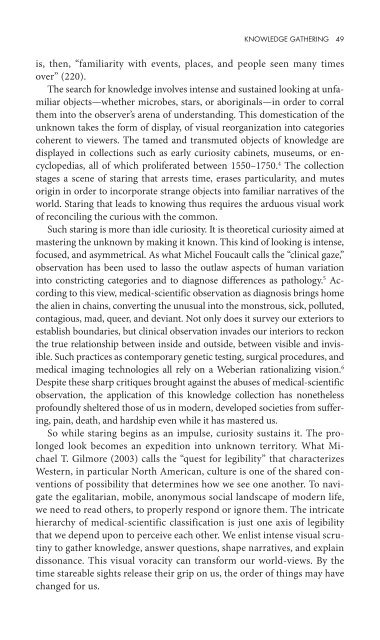Staring how we look sobre la mirada.pdf - artecolonial
Staring how we look sobre la mirada.pdf - artecolonial
Staring how we look sobre la mirada.pdf - artecolonial
You also want an ePaper? Increase the reach of your titles
YUMPU automatically turns print PDFs into web optimized ePapers that Google loves.
20 WHAT IS STARING?<br />
through closeting our conditions. This hiding of disability has made it seem<br />
unusual or foreign rather than fundamental to our human embodiedness.<br />
Rather than accepting disability and accommodating it as an expected part of<br />
every life course, <strong>we</strong> are stunned and alienated when it appears to us in others<br />
or ourselves. 6 When <strong>we</strong> do see the usually concealed sight of disability writ<br />
boldly on others, <strong>we</strong> stare in fascinated disbelief and uneasy identification.<br />
Why, <strong>we</strong> ask with our eyes, does that person with dwarfism, that amputee,<br />
that drooler, <strong>look</strong> so much like and yet so different from me? Such confusing<br />
sights both affirm our shared humanity and challenge our comp<strong>la</strong>cent<br />
understandings. The visibly disabled body intrudes on our routine visual<br />
<strong>la</strong>ndscape and compels our attention, often obscuring the personhood of its<br />
bearer. Sometimes our startled eyes can stay with such a sight, and sometimes<br />
they flee in strained distress. The appearance of disability in the public sphere<br />
makes, then, for a stareable sight. As such, the way <strong>we</strong> imagine human disability<br />
provides us with one of the best opportunities to understand <strong>how</strong> <strong>we</strong><br />
stare.<br />
LOOKING RIGHT AND LOOKING WRONG<br />
We harness the physiological impulse to stare to the pragmatic project of<br />
connecting with the world and making it coherent to us by using staring to<br />
gather information. This goal-driven form of exploratory visual behavior<br />
can be called paying attention, which is a form of social capital, part of the<br />
required skill set for living. 7 The problem of paying attention is <strong>how</strong> to keep<br />
the interest that triggers staring alive when novelty abates. This type of staring<br />
as information collection requires concentrated, focused, and prolonged<br />
<strong>look</strong>ing. To pay attention is to make staring productive and controlled, to<br />
continue the visual engagement when surprise no longer drives scrutiny,<br />
to resist ocu<strong>la</strong>r boredom and the lure of distracting newly novel sights. The<br />
wide-eyed gawking that Langer calls stimulus-driven exploratory behavior is<br />
promiscuous <strong>look</strong>ing; it is always at risk of being seduced away by a fresher,<br />
newly stimu<strong>la</strong>ting sight. Paying attention, in contrast, is visual monogamy, a<br />
deferral of dopamine’s quickie gratification.<br />
Paying attention involves multisensory perception, vision being the primary<br />
vehicle for focused concentration. Jonathan Crary defines attention<br />
as “an imprecise way of designating the re<strong>la</strong>tive capacity of a subject to selectively<br />
iso<strong>la</strong>te certain contents of a sensory field at the expense of others<br />
in the interests of maintaining an orderly and productive world” (1999, 17).<br />
Proper attention is goal-driven, deliberately controlled by our intentions<br />
and strategies (Yantis 1998). As early as 1890, William James, the father of


